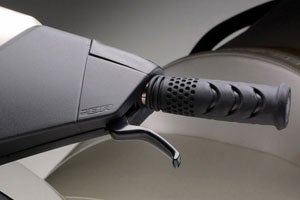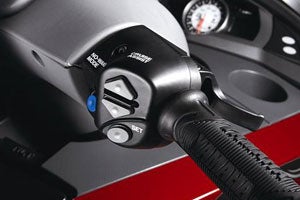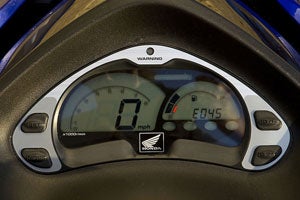Electronic Computer Enhancements for PWC
Operators have more control than ever
There was a time when a personal watercraft’s controls were the ultimate in simplicity. Learn how to squeeze a throttle and turn a handlebar and you pretty much had things mastered. Like automobiles before them, however, the age of electronics and computer brains has allowed personal watercraft to now include a host of new enhancements and possibilities. And in the process, give drivers a whole new level of control over their craft.
Here’s a look at some of the latest developments…and how they can improve your next ride.
Off-Throttle Steering
It’s not a new trend by any means, but one of the bigger changes manufacturers have made in recent years is to incorporate some type of off-throttle steering enhancement. Designed as a means to help drivers avoid collision, off-throttle steering works by sensing the two key signs of a pending mishap — the sudden release of the throttle accompanied by an abrupt, full-lock turn of the handlebars.
Before off-throttle steering, those two movements would result in a craft that had no directional control, as thrust was no longer exiting the pump. Typically the boat would just coast straight ahead, potentially colliding with whatever it was the driver was hoping to avoid. Off-throttle steering enhancements now automatically increase rpm in these instances, giving the craft a gentle burst of power to at least begin a turn in the direction the rider intended when they released the throttle. Ideally, that burst of thrust will allow the craft to avoid the obstacle. At the minimum, it should lessen any potential impact.
While Honda, Kawasaki, and Yamaha have all followed an electronic solution to off-throttle situations, Sea-Doo has added a dual-rudder system to the aft corners of the hull. Release the throttle and these rudders drop down from their pockets in the hull, influencing a turn. Sea-Doo touts an obvious advantage to the system — it works not only in off-throttle situations, but also off-power circumstances. Should the rider panic and pull the lanyard, or simply accidentally disconnect it, the rudders will still allow the boat to have some directional control as it coasts to a stop. In electronic versions, engine thrust alone is relied upon to provide any steering control.
Brakes
 Sea-Doo is the first manufacturer to offer a braking system for a personal watercraft.
Sea-Doo is the first manufacturer to offer a braking system for a personal watercraft.While other manufacturers have yet to follow suit, Sea-Doo took the collision-avoidance idea one step further for ’09, unveiling the industry’s first braking system.
In essence, a computer brain is linked to a beefed-up reverse bucket. Pull the braking handle, located on the left hand grip, and that computer briefly interrupts flow to the pump, allowing the reverse bucket to drop into position. A split second later it resumes a controlled amount of thrust, which is now directed backward to stop the craft. In tests, the system has stopped a brake-equipped boat in roughly one-third to one-half the distance of a conventional model. Pressure on the brake lever can be feathered, much like you would do when approaching a red light, to slow the momentum rapidly, but then soften the final jolt. In this case, it allows the driver to avoid taking a blast of water over the bow.
In practice, the system works surprisingly well. Motion is quickly arrested, and the driver is able to maintain control. The braking system also allows the boat to display other unique characteristics, such as the ability to start in a neutral mode, rather than surge forward the minute thrust begins exiting the pump.
While Sea-Doo is the only major manufacturer currently using a braking system, at least one aftermarket manufacturer is hoping to sell the big names on their own system. Florida-based PWC Industries currently has a patent up for sale for a cable-driven brake that would deploy twin flaps off the PWC’s transom when activated.
Cruise Control
 Just like a car, you can select a cruising speed with the push of a button.
Just like a car, you can select a cruising speed with the push of a button.Yet a third trend being seen in the marketplace is cruise control. Made possible by the switch to electronic, rather than cable-driven throttle systems, cruise control was first introduced by Yamaha in 2008, followed by Sea-Doo in 2009.
Both systems allow drivers to “lock in” a set speed with the simple push of a handlebar-mounted button. From there, the driver simply fully squeezes the throttle, holding onto both handgrips with equal pressure. The systems disengage when throttle pressure is released. Up-down adjustment buttons allow speeds to be gradually raised or lowered. The systems make long-distance cruising much more rider-friendly, as well as make tasks like towing far simpler for the driver, and far more enjoyable for the rider at the end of the line.
Both company’s systems also incorporate a No Wake mode as well. In this case, a simple push of a button locks the craft in around 5 mph, and allows the rider to actually release the throttle all together. This makes navigating a lengthy no-wake zone much easier. Whereas Yamaha’s system locks the boat in at one speed, Sea-Doo’s allows the driver to choose anywhere from 1-7 mph.
Fuel Consumption Displays
 Honda’s fuel consumption display shows you how long you can continue riding at your current speed.
Honda’s fuel consumption display shows you how long you can continue riding at your current speed.A less dramatic, but equally useful enhancement to a rider’s control over his or her craft is the knowledge of how much fuel it is currently using. Touring riders especially will appreciate the knowledge, as the information will help plan how long they can go before the next fuel stop, or how far back they should cut the speed to get the most out of the fuel left in the tank.
Yamaha currently offers fuel consumption displays on select models, as does Honda. The difference? I find Honda’s solution a more usable option, as rather than simply show how much fuel is currently being used, it displays the remaining minutes of running time based on the current fuel load and speed. It’s practical, real-world information.
Get PersonalWatercraft.com in your Inbox!
Like PersonalWatercraft.com on Facebook
Comments
Most Popular

2025 Yamaha JetBlaster PRO 2-Up Review

Remembering the Sea-Doo XP

2024 Kawasaki Jet Ski STX 160X Review

2017 Kawasaki Jet Ski Ultra 310LX Review

Whatever Happened to the Wetbike?











 Your Privacy Choices
Your Privacy Choices